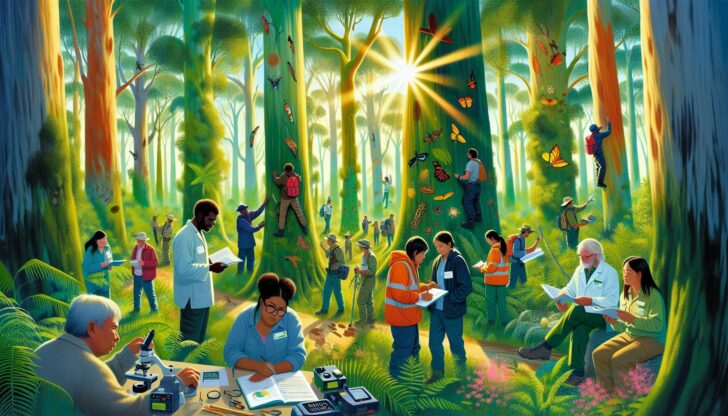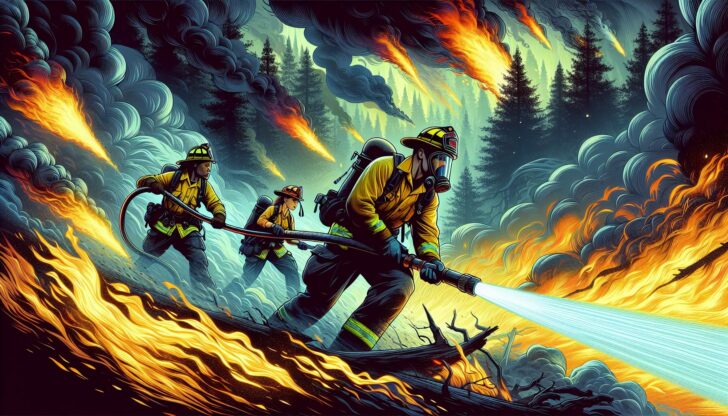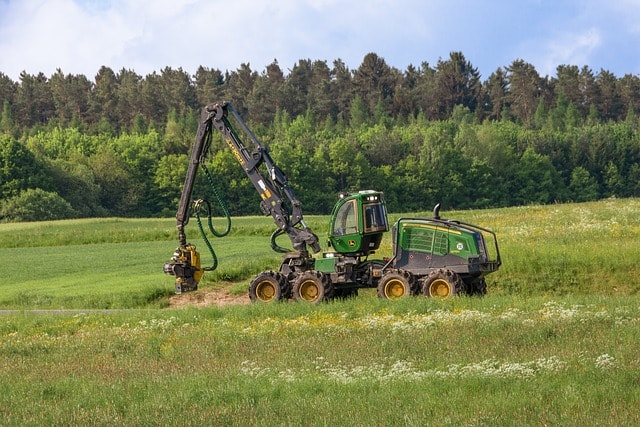Looking to explore the types of forestry jobs? In this article, you’ll discover 10 top forestry careers, the qualifications needed, and what each job involves.
Table of Contents
Key Takeaways
Foresters and conservation scientists are essential for sustainable forest management, with a median annual salary of around $68,750 and steady job growth projected over the next decade.
Forest and conservation workers play a crucial role in maintaining forest health through tasks like clearing vegetation and reforestation, typically earning about $33,940 annually.
There are diverse career paths in forestry, including roles like urban foresters and research foresters, offering various opportunities for education, collaboration, and impact on environmental conservation.
Foresters and Conservation Scientists

Foresters and conservation scientists are the backbone of forest management. They manage forestland sustainably to keep forested areas healthy and productive. These professionals monitor plants and study forest data to maintain the ecological balance. This career path is rewarding both financially, with median annual salaries around $68,750 for conservation scientists and $67,330 for foresters as of May 2023, and intrinsically.
The demand remains steady, with around 36,000 jobs reported in the United States in 2022. Job growth is projected at 4% from 2022 to 2032, aligning with the average for all professions. Most foresters and conservation scientists hold a bachelor’s degree in forestry or a related field, which is essential for entry-level positions. These roles often require working in diverse environments, from office settings to remote outdoor locations.
Foresters handle forest resources by planning tree planting, forest regeneration, and land management. They also supervise forest and conservation workers. Conservation scientists focus on broader environmental issues, conducting research and implementing projects to protect natural resources. Both roles are vital for the sustainability of our forests and the preservation of biological diversity.
These professionals find ample employment opportunities in government sectors, private lands, and advocacy organizations. They often collaborate with other forestry workers, like forest and conservation technicians, to implement sustainable practices and projects. Their work protects forests, supports wildlife populations, and mitigates forest fires’ impacts. Additionally, those interested in national forestry careers can explore various pathways in this vital field.
Students interested in forestry careers can find resources and networking opportunities through organizations like the Society of American Foresters and the Wildlife Society. These organizations offer platforms for undergraduate and graduate students to connect with experienced forestry professionals and explore career paths in the industry.
Forest and Conservation Workers
Forest and conservation workers are the unsung heroes of forestry. They maintain forest health by clearing excess trees and brush, conducting controlled burns, and managing fire risks. They often work with forest and conservation technicians to sustain forest resources.
Typically, forest and conservation workers require a high school diploma or its equivalent for entry-level positions. After hiring, they undergo moderate-term on-the-job training to acquire the necessary skills for their roles. Physical stamina is a key requirement due to the demanding nature of the work. As of May 2023, the median annual salary for forest and conservation workers was approximately $33,940.
They also engage in reforestation activities like planting seedlings and monitoring growth. These tasks are vital for the long-term health and productivity of forested areas. Working closely with conservation scientists and foresters, they significantly contribute to conservation projects and the sustainability of our natural resources.
Forest and Conservation Technicians
Forest and conservation technicians are technical experts supporting foresters and conservation scientists. They measure forest details, assist with quality improvement, and collect forest data. They often work on the ground to ensure projects are implemented correctly and efficiently.
An associate’s degree in a scientific field, preferably forest technology, is typically required to become a forest and conservation technician. Despite a projected employment decline, the practical skills and technical knowledge of these technicians remain invaluable. Training programs equip technicians with skills to support conservation projects and manage forest resources effectively.
They are essential for successfully implementing forestry projects. They work with forestry professionals to protect forests, supervise areas, and ensure reforestation and conservation efforts are carried out as planned. Their technical expertise and hands-on approach make them indispensable.
Learn more, check out Forest Conservation Technician: Salary and Career Facts.
Logging Workers
Logging workers handle timber harvesting, a critical component of the forestry industry. Despite a projected 5% decline in employment from 2022 to 2032, around 7,100 job openings are expected annually due to turnover. This highlights the ongoing need for skilled logging workers to maintain the supply of timber and other forest products.
Logging workers monitor and evaluate operations to ensure compliance with environmental standards. Logging equipment operators maintain machinery, evaluate log quality, and cut trees or logs. Their work ensures sustainable forest management and efficient timber production.
Wildland Firefighters

Wildland firefighters defend against forest fires. They undergo rigorous physical training to handle their demanding job. Physical fitness and endurance are crucial for their challenging outdoor work. Their certification programs include courses on fire behavior, safety protocols, and emergency response techniques.
Effective coordination during fire incidents relies on strong teamwork and communication. They work tirelessly to suppress forest fires, protecting forested areas and mitigating impacts on resources. Their role is vital for both community safety and forest ecosystem conservation.
They often collaborate with forest and conservation technicians, workers, and private landowners to implement fire management strategies. Conducting controlled burns and other preventive measures, they reduce the risk of large-scale suppressing forest fires and enhance forest health and resilience.
Urban Foresters
Urban foresters manage tree populations within city environments. Their work enhances climate resilience and improves urban life quality. These careers often involve landscape design and integrating green spaces into urban development. They collaborate with city planners to create sustainable, aesthetically pleasing urban landscapes.
Managing tree health in densely populated areas presents unique challenges, like addressing urbanization impacts and ensuring safety. Urban foresters mitigate these challenges by implementing effective tree care practices and promoting the benefits of urban trees.
Education and outreach are key components of urban forestry. They raise community awareness about the importance of urban trees and encourage public participation in planting and conservation projects. Their efforts help create greener, healthier, and more sustainable cities.
Forest Wildlife Managers
Forest wildlife managers focus on conserving wildlife populations and their habitats within forested areas. They develop and implement plans to maintain ecological balance and ensure wildlife sustainability. They often work closely with conservation scientists and other forestry workers to achieve their goals.
Certifications like Certified Wildlife Biologist or Certified Forester enhance their expertise and credibility. Their work is vital for protecting biodiversity and promoting forest ecosystem health.
Managing wildlife habitats and populations effectively, they contribute to overall conservation efforts within forestry.
Timber Management Specialists
Timber management specialists develop and implement programs to ensure sustainable forestry practices. They assess timber resources using aerial photographs and on-site surveys to create management plans. They also collaborate with private landowners to promote responsible forest stewardship.
Job prospects are influenced by the demand for forest management. Their expertise is crucial for balancing timber production and forest conservation. Developing annual work plans and monitoring timber resources, they ensure long-term sustainability of forested areas.
They oversee timber harvesting operations and ensure compliance with environmental standards. Their work supports sustainable forest resource use and contributes to forest ecosystem health and productivity.
Research Foresters
Research foresters lead studies on forest ecosystems and biodiversity. They typically need advanced degrees to conduct in-depth research and develop conservation techniques. They collect and analyze data on various environmental factors to safeguard forest ecosystems.
Research foresters are critical for advancing our understanding of forest dynamics and promoting sustainable practices. Their research informs policy decisions, guides conservation efforts, and helps mitigate climate change impacts on forested areas. Exploring innovative solutions, they contribute to the long-term health and resilience of our forests.
Students interested in research forestry should obtain a bachelor’s degree in forestry or a related field. Advanced degrees like a master’s or doctoral degree further enhance their expertise and open specialized research opportunities. They often collaborate with other forestry professionals to address complex environmental challenges and promote resource conservation. Additionally, pursuing a forestry degree can provide a solid foundation for these endeavors.
Equipment Operators in Forestry

Equipment operators in forestry control machinery used for harvesting, reforestation, and road maintenance. They typically undergo on-the-job training to acquire practical machinery operation skills. Understanding machinery design, usage, repair, and maintenance is crucial.
Safety procedures are paramount to ensuring effective and secure operations. They monitor and control equipment to carry out various forestry tasks efficiently. The typical career path may involve obtaining certifications to enhance job prospects and demonstrate expertise.
They work closely with other forestry workers to support sustainable resource management. Their skills and knowledge contribute to the success of forestry projects and the productivity of forested areas. By maintaining and operating heavy machinery, they ensure the smooth functioning of forestry operations.
Summary
In summary, forestry careers offer a diverse range of opportunities for those passionate about nature and conservation. From managing forest health and sustainability to hands-on roles in fire suppression and wildlife management, each career path provides unique challenges and rewards. Whether you are just starting your career journey or looking to make a change, the forestry industry has something to offer.
These roles not only contribute to environmental conservation but also provide fulfilling and dynamic work experiences. By exploring the various forestry careers highlighted in this blog post, you can find the path that aligns with your interests and skills. Embrace the adventure and make a positive impact on our forests and the environment.
Frequently Asked Questions
What education is required to become a forester or conservation scientist?
To become a forester or conservation scientist, a bachelor’s degree in forestry or a related field is typically required. This educational background equips you with the necessary skills for the profession.
What is the median annual salary for forest and conservation workers?
The median annual salary for forest and conservation workers is approximately $33,940 as of May 2023. This figure reflects the current earning potential in this field.
What skills are crucial for wildland firefighters?
Physical fitness, endurance, teamwork, and effective communication are essential skills for wildland firefighters. Mastering these skills is vital for ensuring safety and successful operations in challenging environments.
What do timber management specialists do?
Timber management specialists develop and implement programs for managing timber resources while assessing those resources and collaborating with private landowners. Their expertise ensures sustainable forestry practices and the optimal use of timberlands.
What is the role of research foresters?
Research foresters play a crucial role in studying forest ecosystems and developing sustainable forestry practices through data collection and analysis. Their work is essential for the conservation and management of forest resources.









